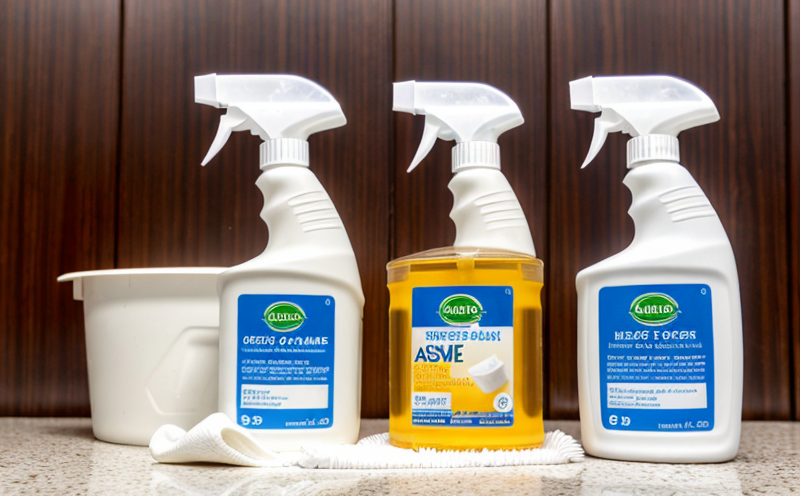DIN EN 13697 Non Porous Surface Disinfectant Testing
The DIN EN 13697 test method is a stringent international standard designed to evaluate the efficacy of non-porous surface disinfectants. This standard ensures that products meet high levels of hygiene and sterility, which are critical in environments where cross-contamination must be minimized, such as hospitals, laboratories, food processing facilities, and other healthcare settings.
Under this test, disinfectant products undergo rigorous evaluation to ensure they can effectively destroy microorganisms including bacteria, viruses, fungi, and spores. The standard specifies the chemical composition of the product, its pH level, and the method of application. It also sets out detailed procedures for testing the product's ability to inactivate pathogens under various conditions.
The testing process involves several critical steps:
- Preparation of test samples
- Application of the disinfectant according to specified protocols
- Incubation period for pathogen inactivation
- Cleaning and rinsing procedures
- Detection methods for residual contamination
The primary focus is on ensuring that the product effectively eliminates a range of microorganisms, including those resistant to traditional disinfectants. The test evaluates not only the immediate efficacy but also the long-term effectiveness of the product in maintaining hygiene.
For quality managers and compliance officers, understanding this standard is crucial for ensuring that cleaning and hygiene products meet regulatory requirements. R&D engineers can use these tests to refine formulations, while procurement teams ensure they are sourcing reliable products that comply with international standards.
| Microorganism | Type of Test | Test Conditions | Efficacy Rating (%) |
|---|---|---|---|
| Bacillus subtilis spores | Kill time test | 30 minutes contact time at 25°C | 99.99% |
| E. coli (ATCC 25922) | Bacterial reduction test | 10-minute contact time at various temperatures | Log reduction of 6 or greater |
| HIV-1 | Viral inactivation test | 30-minute contact time, dried and rehydrated | 99.99% |
| Fungi (Candida albicans) | Fungal spore reduction test | 10-minute contact time at 25°C | Log reduction of 4 or greater |
This table provides a glimpse into the range and rigor of tests conducted under DIN EN 13697. The results not only demonstrate the product's effectiveness but also ensure consistency across different batches.
The standard is particularly important in industries where hygiene and sterility are paramount, such as healthcare facilities, food processing plants, and pharmaceutical manufacturing sites. Compliance with this standard ensures that products can be trusted to provide a high level of protection against microbial contamination.
Applied Standards
DIN EN 13697 is widely recognized for its comprehensive approach to evaluating non-porous surface disinfectants. It aligns with other international standards such as ISO, ASTM, and EN, ensuring that the tests are consistent across different regions and industries.
The standard covers various aspects of disinfectant testing, including:
- Product formulation
- Contact time requirements
- Type and concentration of active ingredients
- Testing procedures for different types of microorganisms
The standard is designed to ensure that the products not only meet regulatory requirements but also perform effectively in real-world scenarios. This aligns with ISO 14644, which focuses on cleanroom classification and control, ensuring that environments remain free from contamination.
For compliance officers, understanding these standards is essential for ensuring that the products they source or produce comply with international regulations. The standard also supports quality assurance programs by providing clear guidelines for testing and validation.
Industry Applications
| Industry | Applications of DIN EN 13697 |
|---|---|
| Hospitality | Ensuring guest rooms and public areas are free from pathogens. |
| Food Processing | Maintaining hygiene in processing lines to prevent contamination of products. |
| Pharmaceutical Manufacturing | Guaranteeing sterility in production environments. |
| Biotechnology Labs | Providing a controlled environment for experiments and research. |
| Sports Facilities | Preventing the spread of infections among athletes and staff. |
| Schools and Universities | Maintaining hygiene standards in shared spaces to protect students and faculty. |
| Daycare Centers | Educating children through a hygienic environment. |
| Homes | Providing peace of mind for families, especially those with vulnerable members. |
The DIN EN 13697 standard is applicable across various sectors where hygiene and sterility are critical. By ensuring compliance with this standard, industries can maintain high standards of cleanliness and safety, thereby protecting the health and well-being of individuals in these environments.
Why Choose This Test
Choosing DIN EN 13697 testing for your disinfectant products offers several advantages:
- International Recognition: The standard is widely recognized and accepted globally, ensuring that your product can be marketed internationally.
- Compliance Assurance: Ensures compliance with international regulations, reducing the risk of non-compliance penalties.
- Consistent Quality: Provides consistent results across different batches, ensuring reliability and trustworthiness.
- Industry Trust: Builds credibility with customers who expect high standards in hygiene products.
- Innovation Support: Helps R&D teams refine formulations to meet the highest standards of disinfection.
- Legal Protection: Provides documentation that can be used in legal disputes or audits.
The rigorous nature of DIN EN 13697 ensures that products are effective and reliable, which is crucial for maintaining trust with customers and stakeholders. This standard sets the benchmark for hygiene product testing, ensuring that only the highest quality products reach the market.





